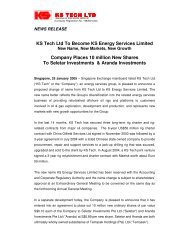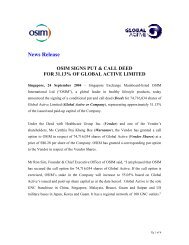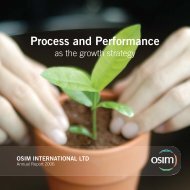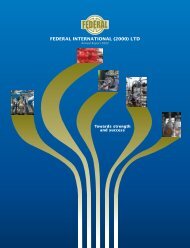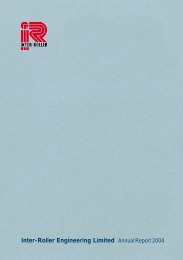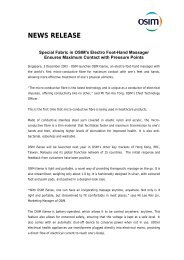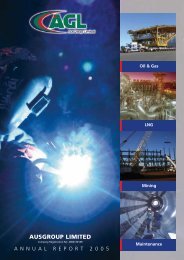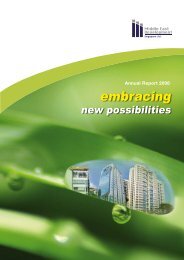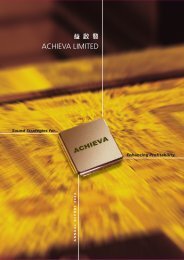ANNUAL REPORT
ANNUAL REPORT
ANNUAL REPORT
You also want an ePaper? Increase the reach of your titles
YUMPU automatically turns print PDFs into web optimized ePapers that Google loves.
42Middle East Development Singapore ltdannual report 2007NOTES TO FINANCIALSTATEMENTS30 June 20072. SUMMARY OF SIGNIFICANT ACCOUNTING POLICIES (Cont’d)TRADE RECEIVABLES – After initial recognition at fair value, trade receivables are measured at amortised cost using the effectiveinterest method except that short-duration receivables with no stated interest rate are normally measured at original invoiceamount unless the effect of imputing interest would be significant. Trade receivables are stated after provision for impairment.The amount of the provision for impairment is recognised in the income statement. A trade receivable amount is regarded asimpaired if there is objective evidence of impairment as a result of one or more events that occurred after the initial recognitionand that loss event has an impact on the estimated future cash flows of the financial asset that can be reliably estimated. Thecarrying amounts of trade receivables are assumed to approximate their fair value. Normally no interest is charged on tradereceivables.LOANS AND RECEIVABLES – Loans and receivables are non-derivative financial assets with fixed or determinable paymentsthat are not quoted in an active market, other than: (a) those that the entity intends to sell immediately or in the near term andare classified as held for trading, and those that the entity upon initial recognition designates as at fair value through profit orloss; (b) those that the entity upon initial recognition designates as available for sale; or (c) those for which the holder may notrecover substantially all of its initial investment, other than because of credit deterioration and are classified as available for sale.After initial recognition such financial assets, including derivatives that are assets, are measured at their fair values, without anydeduction for transaction costs that may be incurred on sale or other disposal, except for the non-current financial assets that areloans and receivables which are measured at amortised cost using the effective interest method less provision for impairment.These items are included in the balance sheet in loans and receivables as current assets or as non-current assets where thematurities are greater than 12 months after the balance sheet date.INVENTORIES – Inventories are measured at the lower of cost (first in first out method) and net realisable value. Net realisablevalue is the estimated selling price in the ordinary course of business less the estimated costs of completion and the estimatedcosts necessary to make the sale. A write down on cost is made for where the cost is not recoverable or if the selling prices havedeclined. Cost includes all costs of purchase, costs of conversion and other costs incurred in bringing the inventories to theirpresent location and condition. In the case of manufactured inventories and work in progress, cost includes an appropriate shareof overheads based on normal operating capacity.CONTRACTS WORK-IN-PROGRESS – When the outcome of a long-term contract can be estimated reliably, the revenue and costsassociated with the contract are recognised as revenue and expenses respectively by reference to the stage of completion of thecontract activity at the balance sheet date using the proportion that contract costs incurred for work performed to date bear tothe estimated total contract costs method. Contract costs consist of costs that relate directly to the specific project, costs that areattributable to contract activity in general and can be allocated to the project and such other costs as are specifically chargeableto the customer under the terms of the contract. Variations in contract work, claims and incentive payments are included to theextent that they have been agreed with the customer. When it is probable that total contract costs will exceed total contractrevenue, the expected loss is recognised as an expense immediately. The long-term work in progress projects have operatingcycles longer than one year. The company includes in current assets amounts relating to the long-term contracts realisable overa period in excess of one year.SUBSIDIARIES – A subsidiary is an entity including unincorporated and special purpose entity that is controlled by the group.Control is the power to govern the financial and operating policies of an entity so as to obtain benefits from its activities accompanyinga shareholding of more than one half of the voting rights or the ability to appoint or remove the majority of the members of theboard of directors or to cast the majority of votes at meetings of the board of directors. The existence and effect of potential votingrights that are currently exercisable or convertible are considered when assessing whether the group controls another entity. In thecompany’s own separate financial statements, the investments in subsidiaries are stated at cost less any provision for impairment invalue. Impairment loss recognised in profit or loss for a subsidiary is reversed only if there has been a change in the estimates usedto determine the asset’s recoverable amount since the last impairment loss was recognised. The net book values of the subsidiariesare not necessarily indicative of the amounts that would be realised in a current market exchange.




